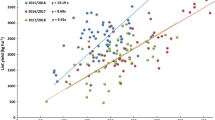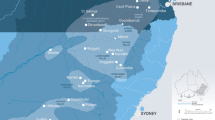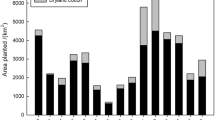Abstract
Soil fertility may decline as a result of nutrient export from high-yielding cotton crops and this may limit the productivity of future crops unless these nutrients are replaced. Uptake of nutrients by cotton (Gossypium hirsutum L.) and nutrient export from the field in seed were measured within two cropping systems experiments from 1999 to 2005 in a flood-irrigated cotton field. Lint yields of the seven crops assessed ranged from 975 to 2725 kg lint/ha. Nutrient uptake was measured at mid to late boll-fill and nutrient removal determined from analysis of delinted seed. Cotton crops accumulated an average of 180 kg N/ha (range 67–403), 27 kg P/ha (range 18–43), 167 kg K/ha (range 88–264), 41 kg S/ha, 160 kg Ca/ha, 36 kg Mg/ha, 7 kg Na/ha, 890 gm Fe/ha, 370 gm Mn/ha, 340 gm B/ha, 130 gm Zn/ha and 51 gm Cu/ha. On average, the seed within harvested seed cotton removed 93 kg N/ha (range 38–189), 18 kg P/ha (range 8–34), 29 kg K/ha (range 13–51), 8 kg S/ha, 4 kg Ca/ha, 12 kg Mg/ha, 0.2 kg Na/ha, 136 g Fe/ha, 12 g Mn/ha, 41 g B/ha, 96 g Zn/ha and 20 g Cu/ha. Nutrients contained in the lint and trash were not included. For crops yielding about 1800 kg/ha, 70% of the Zn and P taken up was removed in the seed, also 52% of N, 38% of Cu, 34% of Mg, 21% of S, 17% of K and Fe, 12% of B and only 3% of Ca, Mn and Na. Predictive equations were developed to allow growers to estimate the removal of nutrients given the lint yield measured from their cotton crops.




Similar content being viewed by others
References
Basinski JJ, Wetselaar R, Beech DF, Evenson JP (1975) Nitrogen supply, nitrogen uptake and cotton yields. Cotton Growing Rev 52:1–10
Bassett DM, Anderson WD, Werkhoven CHE (1970) Dry matter production and nutrient uptake in irrigated cotton. Agron J 62:299–303
Constable GA, Reid PE, Thomson NJ (2001) Approaches utilized in breeding and development of cotton cultivars in Australia. In: Jenkins J, Saha S (eds) Genetic improvement of cotton: emerging technologies. Science Publishers, Inc., Enfield, New Hampshire, pp1–15
Constable GA, Rochester IJ (1988) Nitrogen application to cotton on clay soil: timing and soil testing. Agron J 80:498–502
Constable GA, Rochester IJ, Cook JB (1988) Zinc, copper, iron, manganese and boron uptake by cotton on cracking clay soils of high pH. Aust J Exp Agric 28:351–356
Constable GA, Rochester IJ, Daniells I (1992) Cotton yield and nitrogen requirement is modified by crop rotation and tillage method. Soil Till Res 23:41–59
Cotton Australia (2006) http://www.cottonaustralia.com.au/factSheets/resources/statistics
Dorahy C, Rochester IJ, Blair GJ (2004) Response of field grown cotton (Gossypium hirsutum L.) to phosphorus fertilisation on alkaline soils in eastern Australia. Aust J Soil Res 42:913–920
Duggan BL, Yeates SJ, Gaff N, Constable GA (2006) Phosphorus fertiliser requirements and nutrient uptake of dry season cotton grown on virgin soil in tropical Australia. Comm Soil Sci Plant Anal (in review)
Egelkraut TM, Kissel DE, Caberera ML, Gascho GJ, Adkins W (2004) Nitrogen concentration in cottonseed as an indicator of N availability. Nutr Cycling Agroecosyst 68:235–242
Halevy J (1976) Growth rate and nutrient uptake of two cotton cultivars grown under irrigation. Agron J 68:701–705
Hearn AB (1981) Cotton nutrition. Field Crop Abst 34:11–34
Janat M (2004) Assessment of nitrogen content, uptake, partitioning and recovery by cotton crop grown under surface irrigation and drip fertigation by using isotopic technique. Comm Soil Sci Plant Anal 35(17–18):2515–2535
Katyal JC, Rattan RK, Datta SP (2004) Management of zinc and boron for sustainable food production in India. Fertiliser News 49:83–99
More SD, Agale BN (1993) Phosphate balance studies in irrigated cotton. J Ind Soc Soil Sci 41(3):498–500
Mullins GL, Burmester CH (1990) Dry matter, Nitrogen, Phosphorus and Potassium accumulation by four cotton varieties. Agron J 82:729–736
Mullins GL, Burmester CH (1993) Accumulation of copper, iron, manganese and zinc by 4 cotton cultivars. Field Crops Res 32(1–2):129–140
Nadanassababady T, Kandasamy OS (2002) Effect of chemical and cultural weed control on nutrient removal by cotton and associated weeds. Ind J Weed Sci 34(3–4):316–317
Prasad R, Kumar D, Sharma SN, Gautam RC, Dwivedi MK (2004) Current status and strategies for balanced fertiliser application. Fertiliser News 49(12):73–80
Rich JR, Bird GW (1974) Association of early-season vesicular-arbuscular mycorrhizae with increased growth and development of cotton. Phytopath 64:1421–1425
Rochester IJ, Peoples MB, Constable GA (2001a) Estimation of the N fertilizer requirement of cotton grown after legume crops. Field Crops Res 70:43–53
Rochester IJ, Peoples MB, Hulugalle NR, Gault RR, Constable GA (2001b) Using legumes to enhance nitrogen fertility and improve soil condition in cotton cropping systems. Field Crops Res 70:27–41
Rochester IJ, Peoples MB (2005) Growing vetches (Vicia villosa Roth) in irrigated cotton systems: inputs of fixed N, N fertiliser savings and cotton productivity. Plant Soil 271:251–264
Rochester IJ, Rea M, Dorahy C, Constable GA, Wright P, Deutscher S, Thongbai P, Larsen D (2001c) NUTRIpak—a practical guide to cotton nutrition. Australian Cotton CRC. CSIRO Publishing, Melbourne
Singh J, Kairon MS (2001) Yield and nutrient contents of cotton (Gossypium hirsutum) and sunflower (Helianthus annuus) as influenced by applied sulphur in irrigated Inceptisol. Ind J Agric Sci 71(1):35–37
Soil Survey Staff (1996) Keys to Soil taxonomy, 7th edn. Natural Resources Conservation Service of USDA, Washington DC, p 644
SPSS (2000) SigmaPlot 2000 for Windows. Version 6.00
Srinivasan G (2003) Response of cotton (Gossypium hirsutum) to split application of major nutrients. Ind J Agron 48(1):59–61
Unruh BL, Silvertooth JC (1996) Comparisons between an upland and Pima cotton cultivar: II. Nutrient uptake and partitioning. Agron J 88:589–595
Wang KR, Li SK, Cao LP, Song GJ, Chen G, Cao SZ (2003) A preliminary study on the dynamics and models of N, P and K absorption in high-yielding cotton in Xinjiang. Agric Sci China 2(7):752–759
Wright PR (1999) Premature senescence of cotton (Gossypium hirsutum L.)— Predominantly a potassium disorder caused by an imbalance of source and sink. Plant Soil 211 (2):231–239
Acknowledgements
Financial support from the Cotton Research and Development Corporation and the Cotton Catchment Communities Cooperative Research Centre is gratefully acknowledged. Greg Roberts and Jo Price provided technical assistance and Dr Greg Constable provided valuable comments on the manuscript.
Author information
Authors and Affiliations
Corresponding author
Rights and permissions
About this article
Cite this article
Rochester, I.J. Nutrient uptake and export from an Australian cotton field. Nutr Cycl Agroecosyst 77, 213–223 (2007). https://doi.org/10.1007/s10705-006-9058-2
Received:
Accepted:
Published:
Issue Date:
DOI: https://doi.org/10.1007/s10705-006-9058-2




